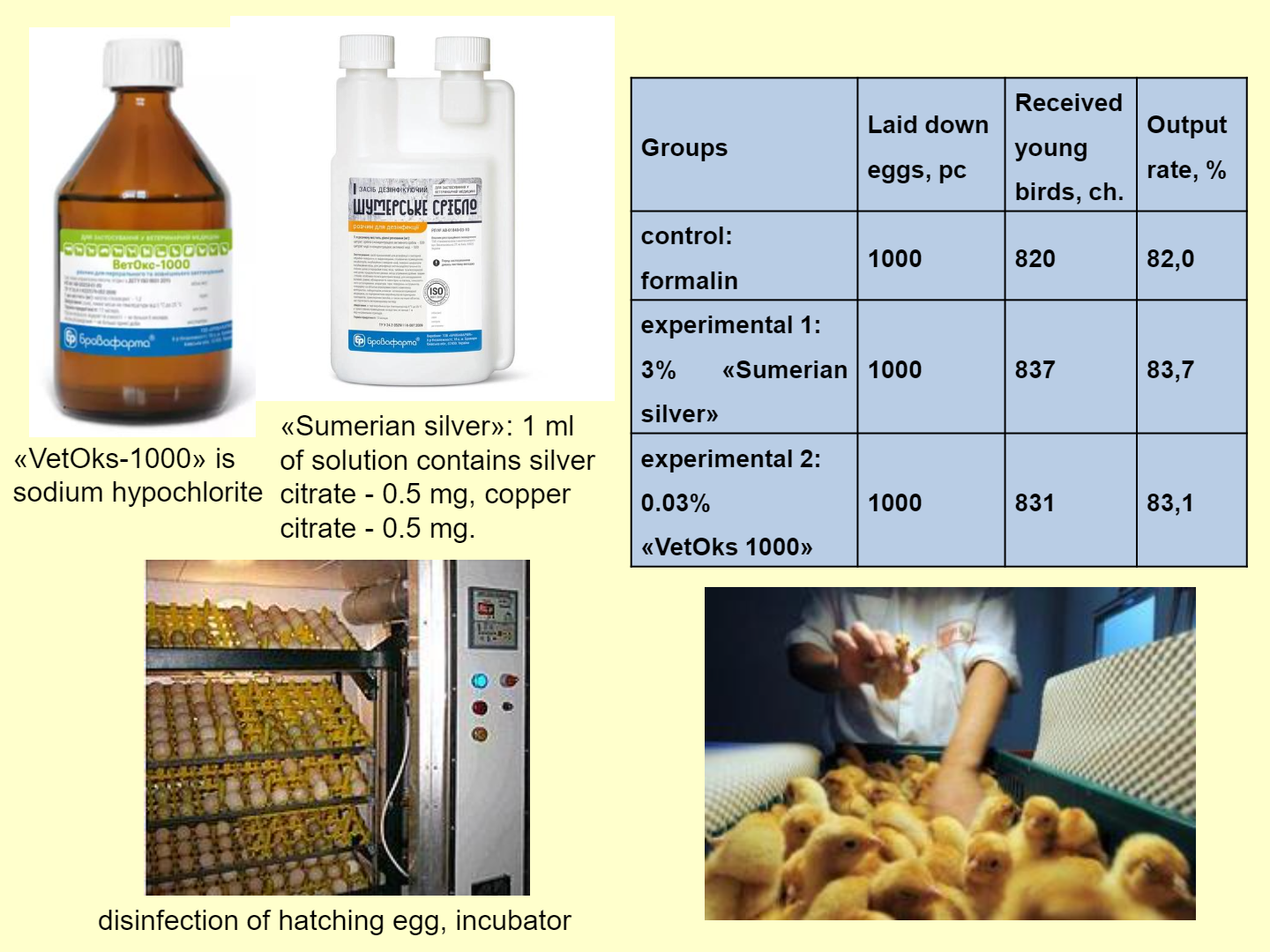Effectiveness of environmentally safe products «VetOks-1000», «Sumerian silver» for the prevention of pseudomonosis of poultry embryos associated with bacteriosis
DOI:
https://doi.org/10.15587/2519-8025.2023.288228Keywords:
«VetOks-1000», «Sumerian silver», P. aeruginosa, E. coli, S. аureus, pseudomonosis of poultry embryos, disinfection of the hatching eggAbstract
The aim: study of the effectiveness of environmentally safe means «Vetoks-1000», «Sumerian silver» for the prevention of pseudomonosis of poultry embryos, associated with bacteriosis.
Materials and methods. The effectiveness of the preparations «VetOks-1000», «Sumerian silver» in relation to E. coli, P. aeruginos, S. aureus, S. typhimurium was determined by the method of researching antimicrobial activity on test objects: galvanized iron, wooden bars (painted and unpainted), red brick and plaster cut-outs, 10 x 10 cm, and a hatching egg.
The effectiveness of «VetOks-1000», «Sumerian silver» solutions compared to formaldehyde for disinfection of hatching eggs and incubation cabinets for the purpose of preventing pseudomonosis of poultry embryos was carried out in the production conditions of the hatchery, where P. aeruginosa, E. coli, S. аureus, were periodically isolated from asphyxiated embryos and from the carcasses of chicks of the first 10 days of life by comparing the hatching rate of chicks in the experimental and control groups.
Results. It was established that the «Sumerian silver» had an antimicrobial effect against the causative agents of pseudomonosis and the main bacterioses of poultry in concentrations of 1–3 %, and the drug «VetOx-1000»was effective in concentrations of 0.024 %–0.03 % after exposure for 1-4 hours in depending on the type of surface.
The number of conditioned young birds, obtained with the use of environmentally safe means «VetOks-1000», «Sumerian silver», was higher by (1.1-1.7) % compared to the number of young birds in the control group using formalin.
Conclusions. The proposed method of prevention of associated pseudomonosis of poultry embryos by rotation of environmentally safe means in established bactericidal concentrations (3 % «Sumerian silver» solution and 0.03 % «VetOks 1000» solution) ensures a 1.1–1.7 % higher hatching of young birds compared to control using formalin
References
- Bezrukavaia, I. Yu. (2001). Epizootychne blahopoluchchia ptakhohospodarstv – tse rentabelnist haluzi ptakhivnytstva. Tvarynnytstvo Ukrainy, 4, 19–21.
- Fotina, T. I., Stepanishchenko, M. M., Fotina, H. A. (2004). Analiz izoliatsii umovno-patohennoi mikroflory v ptakhivnychykh hospodarstvakh Ukrainy. Veterynarna medytsyna, 84, 864–870
- Calnek, B. W., Barnes, H. J., Beard, C. W. (2003). Diseases of poultry. Iowa, 359-397, 412–448.
- Fotina, H. A. (2005). Patohenni vlastyvosti umovno-patohennykh mikroorhanizmiv izolovanykh z tushok ptytsi. Aktualni problemy ta innovatsii v tvarynnytstvi, veterynarnii medytsyni i kharchovykh tekhnolohiiakh. Lviv, 29–31.
- Vashchyk, Y., Morozenko, D., Seliukova, N., Zakhariev, A., Dotsenko, R., Zemlianskyi, A. et al. (2021). Pseudomonas aeruginosa as a priority group representative of bacteria with multiple antibiotic resistance. ScienceRise: Biological Science, 3 (28), 33–40. doi: https://doi.org/10.15587/2519-8025.2021.241238
- Liu, C., Zheng, W., Li, Z., Zhou, L., Sun, Y., Han, S. (2022). Slightly acidic electrolyzed water as an alternative disinfection technique for hatching eggs. Poultry Science, 101 (3), 101643. doi: https://doi.org/10.1016/j.psj.2021.101643
- Motola, G., Hafez, H. M., Brüggemann-Schwarze, S. (2023). Assessment of three alternative methods for bacterial disinfection of hatching eggs in comparison with conventional approach in commercial broiler hatcheries. PLOS ONE, 18 (3), e0283699. doi: https://doi.org/10.1371/journal.pone.0283699
- Motola, G., Hafez, H. M., Brüggemann-Schwarze, S. (2020). Efficacy of six disinfection methods against extended-spectrum beta-lactamase (ESBL) producing E. coli on eggshells in vitro. PLOS ONE, 15 (9), e0238860. doi: https://doi.org/10.1371/journal.pone.0238860
- Al-Shammari, K. I. A., Batkowska, J., Gryzińska, M., Wlazło, Ł., Ossowski, M., Nowakowicz-Dębek, B. (2022). The use of selected herbal preparations for the disinfection of Japanese quail hatching eggs. Poultry Science, 101 (10), 102066. doi: https://doi.org/10.1016/j.psj.2022.102066
- Melo, E. F., McElreath, J. S., Wilson, J. L., Lara, L. J. C., Cox, N. A., Jordan, B. J. (2020). Effects of a dry hydrogen peroxide disinfection system used in an egg cooler on hatchability and chick quality. Poultry Science, 99 (11), 5487–5490. doi: https://doi.org/10.1016/j.psj.2020.05.050
- Hamouda, N. H., Saleh, W. D., Nasr, N. F., El Sabry, M. I. (2023). Benefits and risks of using bacterial- and plant-produced nano-silver for Japanese quail hatching-egg sanitation. Archives of Microbiology, 205 (6). doi: https://doi.org/10.1007/s00203-023-03547-3

Downloads
Published
How to Cite
Issue
Section
License
Copyright (c) 2023 Andriy Berezovskiy, Tetiana Fotina, Yevheniia Vashchyk, Olga Bobrytska, Nataliia Seliukova, Sergey Shtrygol’, Andriy Zakhariev, Ruslan Dubin

This work is licensed under a Creative Commons Attribution 4.0 International License.
Our journal abides by the Creative Commons CC BY copyright rights and permissions for open access journals.
Authors, who are published in this journal, agree to the following conditions:
1. The authors reserve the right to authorship of the work and pass the first publication right of this work to the journal under the terms of a Creative Commons CC BY, which allows others to freely distribute the published research with the obligatory reference to the authors of the original work and the first publication of the work in this journal.
2. The authors have the right to conclude separate supplement agreements that relate to non-exclusive work distribution in the form in which it has been published by the journal (for example, to upload the work to the online storage of the journal or publish it as part of a monograph), provided that the reference to the first publication of the work in this journal is included.








